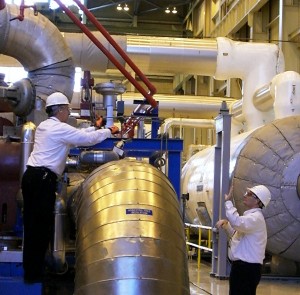
Facing added scrutiny by state and county government officials of its already closely scrutinized Indian Point, Entergy Corp. turned to New York”™s daily newspapers to assure the public its nuclear plant in Buchanan is safe from earthquakes and protected against the power-failure scenario that plunged Japan into a nuclear crisis this month.
Entergy officials said they welcomed a Nuclear Regulatory Commission review of Indian Point sought by the plant”™s long-time opponent, Gov. Andrew Cuomo. Cuomo, who lives in Westchester County, in the past has said Indian Point is “a catastrophe waiting to happen” and should be closed immediately.
While serving as New York attorney general, he said the state was ready for “a protracted legal battle” to squash the NRC”™s relicensing of Entergy”™s two working nuclear generators in Buchanan. The plant”™s current operating licenses expire in 2013 and 2015.
NRC: U.S. Nuclear plants are safe
On the same day that top Cuomo administration officials traveled to Rockville, Md., to press Nuclear Regulatory Commission officials to make Indian Point the first priority in the federal agency”™s planned review of seismic risk at nuclear plants around the nation in the wake of the Japanese disaster, Entergy took out a full-page ad in The New York Times and other papers to ease public concerns about the risks posed by Indian Point”™s location in the Ramapo Fault seismic zone.
In an open letter to New York citizens, Entergy Chairman and CEO J. Wayne Leonard contrasted “the thoughtful response of public officials and regulators” to the Fukushima reactor failures to attempts by nuclear power opponents “to use the crisis in Japan to escalate the fears of the public in order to further their longstanding goals of closing Indian Point.”
Leonard cited U.S .Energy Secretary Steven Chu”™s recent statement that federal officials believe Indian Point to be safe. He also pointed to findings by the NRC and the independent Institute of Nuclear Power Operations that Indian Point is safe.
The NRC in a recent report said the nuclear plant failure in Japan has not shaken the agency”™s perception of earthquake hazards at U.S. nuclear plants. “The NRC continues to determine that U.S. nuclear plants are safe,” the report stated.
Heightened scrutiny at the local level
In White Plains, Entergy Nuclear officials offered similar assurances about Indian Point to the environment and energy and public safety committees of the Westchester County Board of Legislators. The fact-gathering meeting, which especially focused on Indian Point safety design features and power backup systems, was the first of several the committee will schedule as part of the heightened government scrutiny of the plant”™s potential risks to public safety.
County Legislator Michael B. Kaplowitz, D-Somers, environment committee chairman, said he plans to call in seismic experts and NRC and Federal Emergency Management Agency officials to the weekly meetings. He said the committee also will explore the reuse of the Indian Point site to generate electricity from alternative energy sources such as natural gas.
John McCann, Entergy Corp. vice president of nuclear safety, emergency planning and licensing, said the plant was designed to withstand earthquakes of a magnitude 6 on the Richter scale, greater than any quake recorded in the region. “The earthquake in Japan was essentially 1,000 times greater than the earthquake that we designed for,” he said.
Entergy CEO Leonard in his public letter noted Indian Point was designed to withstand an earthquake 100 times the magnitude of the strongest quake recorded in this area.
McCann told legislators, “I would say categorically Indian Point is not susceptible to the kind of earthquake as in Japan and, probably more importantly, to the tsunami.”
Flooding from the tsunami knocked out backup generators and pumps needed to keep nuclear fuel submerged in water and prevent radioactive releases from overheated fuel rods. “If it were only the earthquake they had to deal with, we probably wouldn”™t be here having this discussion today,” McCann said.
McCann said Indian Point was designed to withstand a 100-year flood with a built-in safety margin.
Asked whether events in Japan could lead to operational changes at Indian Point, Michael J. Slobodien, Entergy emergency programs director, said, “There undoubtedly will be many lessons that we take from Japan, both NRC and the industry. I have no doubt there will be changes we will make in response to this event.”
In Albany, Cuomo said NRC staff, after meeting with New York officials led by Lt. Gov. Robert J. Duffy, pledged to put Indian Point at the top of the agency”™s review of seismic risk at 27 nuclear plants. The NRC agreed to cooperate with the state in a joint review of the Buchanan plant. Cuomo said NRC Chairman Gregory B. Jaczko agreed to personally inspect the site on the Hudson River with New York officials.
A spokesperson at the NRC, though, told the New York Post those reviews will not be done until 2012. Elizabeth Hayden was quoted by the Post as saying the reviews will not be expedited “because this is really not a serious concern.”
“It would be unrealistic to think these events will not have some impact on the business,” Ken Theobalds, Entergy vice president of government affairs, told county legislators. “Time will tell what that impact is.”
Energy and the economic impact
Theobalds said Indian Point generates 2 megawatts of electricity, enough to power about 2 million homes. A wholesaler, Entergy sells its power to Consolidated Edison Corp. and the New York Power Authority.
Theobalds said Indian Point supplies from 18 percent to 38 percent of this region”™s electrical needs, depending on seasonal demand. It makes up a larger share of the electrical load in New York City and the region in winter months, he said.
Business and labor groups supporting the plant”™s relicensing say closing Indian Point would leave the region without that reliable power source and result in power shortages.
Closing the Entergy plant also would leave the region without one of its larger employers and a major taxpayer.
The company employs about 1,250 plant and operations support workers in Buchanan and at Entergy Nuclear headquarters in White Plains. Entergy pays approximately $25.5 million in taxes and payments in lieu of taxes to local municipalities and Westchester County, including more than $20 million to the Hendrik Hudson School District.
“The nature of energy production is that there are not any ”˜no risk”™ options,” said John Durso Jr., executive director of the New York Affordable Reliable Electricity Alliance, in a statement following Entergy officials”™ meeting with county legislators. His organization represents about 150 business, labor and community groups in the metropolitan area, including Entergy.
“Safety must always be paramount and we must recognize that nuclear energy, by ensuring a stable electricity grid and reducing toxic emissions, actually makes the region a cleaner, safer place,” Durso said.


















